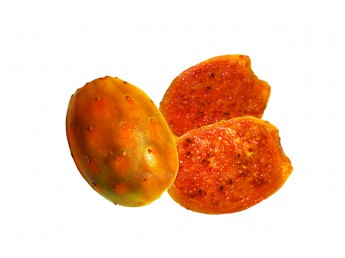 In addition to its properties, the stalks you or blades contain a pulp with many medicinal properties. Is usually applied on sore areas, to relieve lower back pain or chronic rheumatism. Also, the dry flower of the white tuno, also has virtues, among them are the reduce inflammations and sore muscles.
In addition to its properties, the stalks you or blades contain a pulp with many medicinal properties. Is usually applied on sore areas, to relieve lower back pain or chronic rheumatism. Also, the dry flower of the white tuno, also has virtues, among them are the reduce inflammations and sore muscles.
It is the time in which we can observe in the fields, slopes and ravines, the multitude of "loaded with tunos" Cactus, a few Orange and other whites, Depending on the area. However, poor marketing and competition from other fruits have been relegated to the humble tuno at their lowest times.
That is why in the autumn we can observe the same almost past tunos, hanging from stalks in an image that denotes what abandonment a few decades ago, When would the hunger kill many Canaries, It would have been impossible to see.
[quote]The tunera (Opuntia ficus - indica)It is native to Mexico where it is known with the name of Cactus. After the discovery of America, Spanish-Castilian brought to the Canary Islands and the Iberian Peninsula.[/quote]
It is estimated that you there are more than 80 varieties of Cactus, which enriches the diversity of commercially available tunos. The fruit has multiple names: tuno, prickly pear, Fig peak or fig I chumbo and it brings them commercially according to your colour: Red, Purple, yellow-orange and white.
The cultivation of the Canarian tuno had their golden centuries, from the fifteenth to the twentieth century, observed in many areas dry and scarce rainy large amounts of this plant that have survived the strong prevailing of the Midlands heat and precipitation South of Gran Canaria.
The tunos in their collection require great care, in fact, Thanks to the "spinning" (a long cane open-sided in shape of mouth and tied with a thread) facilitates its collection.
While in the Canary Islands only the tuno has is directly consumed or spent (porreto) in America there is a wide variety of products ranging from cheese tunera, flour, syrup, wine, honey, juice and essences, up to forage for livestock.
Source of health
The tuno has a nutritional value that makes it stand out regarding other fruits. It is rich in calcium, potassium, phosphorus, Selenium, copper and zinc. Provides significant amounts of vitamin C and small amounts of various B-complex vitamins.
In addition to alkaline, is an excellent source of calories (1 kilo of tunos brings more than 600 calories) so it is not advisable on a slimming diet and it is absolutely forbidden for people with diabetes because of its high content in sugars.
Tuna shell represents of the 40 to the 50% fruit , the pulp of the 40 to the 50% and the seeds of the 5 to the 10%.
It is a good laxative and also helps our immune system, cardiovascular and nutritional. It must take into account not to exceed in taking it since it can be indigestible and cause disorders.
The tuno contains a pigment called betalain which acts as an antioxidant, which has anti-cancer activity including greater than vitamin C. It also prevents the oxidation of fat, preventing the formation of atherosclerosis plaque, so it is highly recommended for those people living with stress or having unhealthy life habits.
[quote]The pulp has antiseptic and astringent properties, so it is recommended for people who suffer from diarrhea. The alkalizing properties so advise those suffering from gastric ulcers.[/quote]
It is also recommended for those people who suffer from coronary heart disease, It contains an alkaloid called cantina, which is a cardiac tonic which increases the strength and breadth of the contractions of the heart.
CONTENT FOR EACH 100 GRAMS:
Component unit quantity
AGUA gr. 87.55
ENERGY Kcal. 41
PROTEINS gr. 0.73
LIPIDS g. 0.51
CARBOHYDRATE g. 9.57
FIBRA gr. 3.60
CALCIUM mgr. 56
MAGNESIUM mgr. 85
PHOSPHORUS mgr. 24
POTASSIUM mgr. 220
SODIO mgr. 5
ZINC mgr. 0.12
COBRE mgr. 0.08
SELENIO mgr. 0.60
VITAMINA C Bishop. 14
TIAMINA mgr. 0.014
RIBOFLAVINA mgr. 0.06
NIACINA mgr. 0.460
VITAMINA B6 mgr. 0.06
FOLATO Bishop. 6
VITAMINA A IU. 51
Vitamin E gr. 0.01
FAT SATURATED gr. 0.067
MONOUNSATURATED gr. 0.075
POLYUNSATURATED gr. 0.210
Recent scientific research has identified two types of betalains (pigment): betaxanthines giving the yellow-orange (of which a single compound called indicaxantin part) and the betacyaninas that give the color purple, (It is noteworthy that the white tuna also contains these substances).
Another set of the tuno compounds that contribute to enhance its antioxidant effects have also been identified, namely: phenolic compounds, flavonoids and vitamin C.
Study on test tubes made in the Department of biotechnology and food engineering of the Tecnológico de Monterrey, It was noted that colorado tuno juice inhibited the development of colon and prostate cancer cells.
 A neuroprotective effect has also been shown and it has been observed that the tuno promotes the secretion of bicarbonate to gastric level providing an antacid and protective effect of gastric mucosa.
A neuroprotective effect has also been shown and it has been observed that the tuno promotes the secretion of bicarbonate to gastric level providing an antacid and protective effect of gastric mucosa.
The content of betalains, It is higher in red and purple varieties in the yellow-orange and white, and this also varies depending on the conditions of cultivation and the degree of maturity of the tuna, at the time of consuming it.
Seen as a whole, These studies have shown that consumption of tunos improves the stadium of anti-oxidation in the body of healthy people, It reduces blood fats oxidation processes (cholesterol and triglycerides), and it increases the neutralization of free radicals.
"Although it l'espine me hand"
As the song says, the excellent properties of the humble tuno are proven to not realize consuming it by so feared thorns.
In addition, Peel a tuno is an art within the reach of anyone who allows us to demonstrate skills and abilities sufficient to deal with such task.
Too bad that while an important part of the world is hungry, We have tunerales scattered throughout Canarias, whose tunos, for the most part, they rot or fall because the current feed opts for others 'toxic'.

